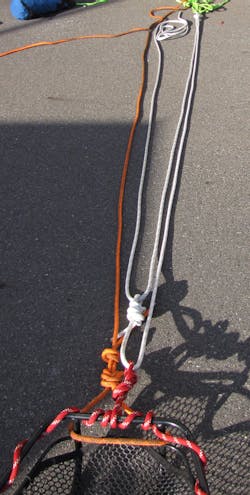The basis of this article is to show that engine and truck companies with limited rope and rope hardware can still affect a successful rescue. All it takes is a little outside-the-box thinking and an understanding of how applied forces will move objects. I would also like to convey that the information and techniques in this article are designed for a minor slope-type evacuation. This serves as a means for an engine or truck crew to bring someone to a safe area if they conditions are safe and don't include the the possibility of a straight vertical drop.
To start things off, and to obtain an easy understanding of how we’re going to achieve our goals using limited or no rope hardware, let’s look at a simple 2:1 mechanical advantage system (MAS). Like any rope system, we need a good anchor. From there, we’ll take our rope and run it through the bead of the stokes basket and back towards the anchor. In three easy steps you have an MAS that will cut your load in half.
Normally, we would place a pulley on the head of the stokes and run the rope through it. However, we can achieve the same goal by just running the rope through the head of the stokes. Sure, we pick up more friction by not running the rope through a pulley; however, the friction gain and effect on the hauling operation will be minimal. A 2:1 MAS is a quick, effective, and simple means of hauling something or someone to a desired location of safety.
Now that you’re warmed up and have a feel for what’s going on in this article, let’s look at another MAS system – the 3:1 (see Figures 1 and 1A). When building systems without hardware, you really need a good eye and a understanding for what’s going on and what needs to happen. When I say that, I’m referring to the building and theory of mechanical advantage systems. A little knowledge will go a long way.
Let’s begin this system by tying the rope to the stokes with a Figure-8 follow through. This will give us a fixed connection point to the stokes as well as a life safety knot. Next, look for a good anchor point, bombproof of course (see Figure 2). Now, utilize two Figure-8 bites or one double-eight bite knot, making sure the knot(s) are facing the load. Next, run the load rope through the knot and bring it back up to the load. At this point we would connect a pulley onto the load line, however, because we don’t have any hardware, we’ll simply tie a butterfly knot in the load line just underneath the main knot. Now we’ll take the rope that we just fed through the knot located at the anchor and pass it through the butterfly knot and bring it back in the direction of the anchor. There you have it a 3:1 MAS with no hardware.
Creating a Hauling System
On a normal MAS you would have a progress capture device (PCD). This would hold the load during longer hauling operations. The system we just built is designed for a single stroke, meaning we can get the load from point A to point B without having to reset the system. We will, however, attach a safety line to the stokes and run that rope through a separate rope tied to our anchor (see Figure 3). We can then stop and hold the load by simply crossing the rope over itself (see Figure 3A). The friction created by the bend of the rope is sufficient enough for a rescue to securely hold the load.
Now, let’s create a 4:1 MAS (see Figure 4). We’ll begin this time from our anchor, so do a proper rigging size-up and find the best possible anchor that’s inline with the intended load. Like we did earlier, we’ll wrap the anchor with a length of rope. However, this time we’ll need to leave them untied (you’ll understand why in just a bit). Next, we’ll take our rope and create what looks like two upside down J’s. Now, we’ll need to create a connection point on our load. This can be done simply by taking a short piece of rope and tying it around the head of the stokes, finishing it with an eight on a bite. Now, working left to right, the first “J” you created will need to pass through the knot on the rope you just tied onto the stokes. At the end of that rope, tie a Figure-8 bite. Next, pass the second “J” you created through the eight on a bite you just tied and bring that rope down toward the load. That’s the rope you’ll be hauling with. Now, take a step back and give yourself a pat on the back because you’ve built a 4:1 MAS using no hardware. Wait, we’re not done yet! Be sure to attach a safety line to the stokes and, just like on the 3:1 MAS, this will act as a “belay.” We’ll create another anchor point using the same method as we used with our original anchor.
For any seasoned rope users who are reading this, allow me to answer the question that’s been burning in your mind this entire article. Being that we’re using no hardware and utilizing knots to redirect our rope, we’re going to be creating the worst kind of friction we could possibly create – “Rope on Rope.” Because this is an operation for departments or companies who may have little or no gear other than rope, here’s a quick fix for that problem. Cut small pieces of garden hose (see Figure 5) to fit over the rope wherever it will be rubbing. This is a cheap fix that any department can afford.
Safety Is Vital, Even With Limited Gear
Depending on where you’re located, and the response time of outside agencies, you may very well be a victim’s last chance. Injuries may not allow the victim to wait 20 or 30 minutes for a team to arrive, so it’s up to you to make something happen using what you have. I will stress, however, that safety should never be compromised in any operation. A true professional can think outside the box and maintain an effective safety margin throughout the operation.
I hope this article sparked some creative ideas for training. I also hoped it showed companies who are not directly involved in rope rescue that with a little knowledge and training they could make a big difference in the overall outcome of a victim’s fate and well being. Above all else, training is what makes ideas and skills like the ones you just read work. When it comes to someone’s life, you shouldn’t question your skills or ability. Remember, “Training prepares you for moments that define you.”
Stay safe and stay progressive.
MICHAEL R. DONAHUE is a 14-year veteran of the fire service is assigned to Rescue Company 1 in Elizabeth, NJ. Mike is the owner and founder of Progressive Rescue, a company dedicated to further firefighter's in all aspects of the job. He holds the title of rescue specialist with New Jersey's Urban Search and Rescue Team (NJ-TF1) and he is actively teaching at Middlesex Fire academy and the Middlesex County College as their Fire Science Program Coordinator. Mike has been on two Firehouse.com podcasts: The Buzz on Technical Rescue: Rope Rescue Operations and The Buzz on Technical Rescue: Special Operations Roundtable. He has taught as a HOT instructor at Firehouse Expo and is the Specialized Rescue Forum moderator for Firehouse.com. You can reach Michael by e-mail at [email protected].

Michael Donahue
Owner and founder of Progressive Rescue, Mike Donahue is a 13-year veteran to the fire service. In those thirteen years Mike has experience as both a volunteer and federal firefighter and has been a career firefighter in the City of Elizabeth for the last 10 years, the last seven of which and currently working out of Rescue Company 1. Mike holds the title of Rescue Specialist with New Jersey's urban search and rescue team (NJ-TF1). You can find Mike actively teaching at Middlesex and Somerset Fire Academies as well as Middlesex County College as an Adjunct Professor and the Fire Science Program coordinator. He is actively involved in writing new course programs for the various organizations he teaches for. Mike has reviewed several text books for publishers such as Delmar and Jones & Bartlett. Mike has also co-written the new rope program for Jones & Bartlett and taught Rope Rescue Made Simple at Firehouse Expo 2010. Mike also is a monthly columnist for Firehouse.com covering the area of technical rescue. His teaching techniques and cutting edge style have gained the respect from many of his peers. Mike's passion, experience and desire to educate emergency service providers prove to be the driving force that has made him so successful. Progressive Rescue prides itself on providing the most cutting edge, diverse instructional programs available. We strive to provide your department with the most comprehensive, dynamic learning experience available at a truly competitive price. You can reach Mike by e-mail at [email protected]





